Post-Agricultural Shifts in Soils of Subarctic Environment on the Example of Plaggic Podzols Chronosequence
Abstract
1. Introduction
2. Materials and Methods
3. Results and Discussion
- S5—Hortic Podzol (Arenic, Cordic)—0 years of abandonment (field);
- S6—Plaggic Albic Podzol (Arenic, Cordic)—5 years of abandonment;
- S8—Plaggic Ortsteinic Podzol (Arenic)—10 years of abandonment;
- S4—Plaggic Turbic Gleyic Ortsteinic Podzol (Arenic)—16 years of abandonment;
- S2—Plaggic Turbic Ortsteinic Podzol (Siltic)—17 years of abandonment;
- S3—Plaggic Podzol (Siltic, Cordic)—20 years of abandonment;
- S1—Plaggic Ortsteinic Podzol (Siltic)—25 years of abandonment;
- Mature soil—Histic Entic Podzol (Folic)—no disturbed soil.
3.1. Dynamics in SOC and “Soil Health” Ratios
3.2. Dynamics of Soil Fertility and Nutrients Concentrations
3.3. Potentially Toxic Elements and Micronutrients Concentrations
4. Conclusions
Author Contributions
Funding
Data Availability Statement
Acknowledgments
Conflicts of Interest
References
- Masson-Delmotte, V.; Zhai, P.; Pirani, A.; Connors, S.L.; Pean, C.; Berger, S.; Caud, N.; Chen, Y.; Goldfarb, L.; Gomis, M.I.; et al. IPCC 2021: Summary for Policymakers. In Climate Change 2021: The Physical Science Basis; Contribution of Working Group I to the Sixth Assessment Report of the Intergovernmental Panel on Climate Change; Cambridge University Press: Cambridge, UK, 2021. [Google Scholar]
- Poeplau, C.; Schroeder, J.; Gregorich, E.; Kurganova, I. Farmers’ Perspective on Agriculture and Environmental Change in the Circumpolar North of Europe and America. Land 2019, 8, 190. [Google Scholar] [CrossRef]
- Tchebakova, N.; Parfenova, E.; Lysanova, G.; Soja, A. Agroclimatic potential across central Siberia in an altered twenty-first century. Environ. Res. Lett. 2011, 6, 045207. [Google Scholar] [CrossRef]
- Unc, A.; Altdorff, D.; Abakumov, E.; Adl, S.; Baldursson, S.; Bechtold, M.; Cattani, D.J.; Firbank, L.G.; Grand, S.; Guðjónsdóttir, M.; et al. Expansion of Agriculture in Northern Cold-Climate Regions: A Cross-Sectoral Perspective on Opportunities and Challenges. Front. Sustain. Food Syst. 2021, 5, 663448. [Google Scholar] [CrossRef]
- Klöffel, T.; Young, E.; Borchard, N.; Vallotton, J.; Nurmi, E.; Shurpali, N.; Tenorio, F.U.; Liu, X.; Young, G.; Unc, A. The challenges fraught opportunity of agriculture expansion into boreal and Arctic regions. Agric. Syst. 2022, 203, 103507. [Google Scholar] [CrossRef]
- Jones, M.W.; Habeck, J.O.; Ulrich, M.; Crate, S.; Gannon, G.; Schwoerer, T.; Jones, B.; Kanevskiy, M.; Baral, P.; Maharjan, A.; et al. Socioecological dynamics of diverse global permafrost-agroecosystems under environmental change. Arct. Antarct. Alp. Res. 2024, 56, 2356067. [Google Scholar] [CrossRef]
- National Report “Global Climate and Soil Cover of Russia: Arctic zone, Permafrost Soils—To the Future of Russia (Agriculture and Forestry)”; Ivanov, A.L., Goryachkin, S.V., Lapteva, E.M., Kozlov, D.N., Bolotov, A.G., Dukhanin, Y.A., Stolbovoy, V.S., Sukhacheva, E.Y., Konyushkov, D.E., Abakumov, E.V., et al., Eds.; Soil Institute: Moscow, Russia, 2024; 672p. (In Russian) [Google Scholar]
- Nizamutdinov, T.; Zhemchueva, D.; Zverev, A.; Andronov, E.; Pechkin, A.; Abakumov, E. Agropedogenesis and related changes in morphology, fertility and microbiome diversity of soils in cryogenic ecosystems on the example of the central part of Yamal region (West Siberia). Geoderma 2024, 449, 117014. [Google Scholar] [CrossRef]
- Nilsson, A.E.; Larsen, J.N. Making Regional Sense of Global Sustainable Development Indicators for the Arctic. Sustainability 2020, 12, 1027. [Google Scholar] [CrossRef]
- Alekseeva, L.V. The Formation of Polar Agriculture in the USSR (Based on the Materials of Yamal). Bull. Nizhnevartovsk State Univ. 2017, 2, 3–10. (In Russian) [Google Scholar]
- Nizamutdinov, T.; Suleymanov, A.; Morgun, E.; Yakkonen, K.; Abakumov, E. Soils and olericultural practices in circumpolar region of Russia at present and in the past. Front. Sustain. Food Syst. 2022, 6, 1032058. [Google Scholar] [CrossRef]
- Morgun, E.N.; Abakumov, E.V. Agricultural research and crop yields in the Yamal-Nenets autonomous district: Retrospective analysis (1932–2019). Sci. Bull. Yamalo-Nenets Auton. Dist. 2019, 3, 4–9. (In Russian) [Google Scholar]
- Morgun, E.N.; Abakumov, E.V.; Nizamutdinov, T.I.; Ilyasov, R.M. Polar agriculture in the Yamalo-Nenets Autonomous Okrug. In Revival; Center of Scientific and Production Technologies “Asterion”: St. Petersburg, Russia, 2022; 250p. (In Russian) [Google Scholar]
- Suleymanov, A.; Nizamutdinov, T.; Morgun, E.; Abakumov, E. Evaluation and Spatial Variability of Cryogenic Soil Properties (Yamal-Nenets Autonomous District, Russia). Soil Syst. 2022, 6, 65. [Google Scholar] [CrossRef]
- Tikhanovsky, A.N. Potatoes in Yamal. In Novosibirsk; Publishing House “Akademizdat”: Moscow, Russia, 2021; 160p. (In Russian) [Google Scholar]
- IUSS Working Group WRB. World Reference Base for Soil Resources. In International Soil Classification System for Naming Soils and Creating Legends for Soil Maps, 4th ed.; IUSS: Vienna, Austria, 2022. [Google Scholar]
- Global Soil Partnership. Standard Operating Procedures (SOPs). Available online: https://www.fao.org/global-soil-partnership/glosolan-old/soil-analysis/standard-operating-procedures/en/ (accessed on 3 March 2024).
- FAO. Standard Operating Procedure for Soil Bulk Density, Cylinder Method; FAO: Rome, Italy, 2023. [Google Scholar] [CrossRef]
- FAO. Standard Operating Procedure for Soil pH Determination; FAO: Rome, Italy, 2021. [Google Scholar]
- FAO. Standard operating procedure for soil organic carbon. In Walkley-Black Method: Titration and Colorimetric Method; FAO: Rome, Italy, 2019. [Google Scholar]
- Heiri, O.; Lotter, A.F.; Lemcke, G. Loss on Ignition as a Method for Estimating Organic and Carbonate Content in Sedi-ments: Reproducibility and Comparability of Results. J. Paleolimnol. 2001, 25, 101–110. [Google Scholar] [CrossRef]
- FAO. Standard Operating Procedure for Soil Nitrogen—Kjeldahl Method; FAO: Rome, Italy, 2021. [Google Scholar]
- Kroetsch, D.; Wang, C. Particle size distribution. In Soil Sampling and Methods of Analysis, 2nd ed.; Carter, M.R., Gregorich, E.G., Eds.; CRC Press: Boca Raton, FL, USA, 2007; pp. 713–725. ISBN 9780849335860. [Google Scholar]
- Kreyer, K.G.; Bankina, T.A.; Orlova, N.E.; Yur’eva, G.M. Practical tasks on agrochemical soil analysis. In Textbook, 3rd ed.; Revision and Addendum; St. Petersburg University Press: St. Petersburg, Russia, 2005; 88p. (In Russian) [Google Scholar]
- FAO. Standard Operating Procedure for Quasi Total Elements in Soil by Acid Digestion, Including Heavy Metals; FAO: Rome, Italy, 2023. [Google Scholar]
- Kowalska, J.B.; Mazurek, R.; Gąsiorek, M.; Zaleski, T. Pollution indices as useful tools for the comprehensive evaluation of the degree of soil contamination—A review. Environ. Geochem. Health 2018, 40, 2395–2420. [Google Scholar] [CrossRef]
- Hàkanson, L. An Ecological Risk Index for Aquatic Pollution Control. A Sedimentological Approach. Water Res. 1980, 14, 975–1001. [Google Scholar] [CrossRef]
- Department of Natural Resources and Ecology of the Yamalo-Nenets Autonomous Okrug. Handbook on the Application of Regional Values of the Content of Controlled Components at Regional Environmental Monitoring Sites in Assessing the Status and Level of Environmental Pollution on the Territory of the Yamal-Nenets Autonomous Okrug. 2020. Available online: https://dprr.yanao.ru/documents/other/132628/ (accessed on 14 April 2024). (In Russian).
- Kalinina, O.; Cherkinsky, A.; Chertov, O.; Goryachkin, S.; Kurganova, I.; Lopes de Gerenyu, V.; Lyuri, D.; Kuzyakov, Y.; Giani, L. Post-agricultural restoration: Implications for dynamics of soil organic matter pools. Catena 2019, 181, 104096. [Google Scholar] [CrossRef]
- Vasilchenko, A.V.; Vasilchenko, A.S. Plaggic anthrosol in modern research: Genesis, properties and carbon sequestration potential. Catena 2024, 234, 107626. [Google Scholar] [CrossRef]
- Hubbe, A.; Chertov, O.; Kalinina, O.; Nadporozhskaya, M.; Tolksdorf-Lienemann, E.; Giani, L. Evidence of plaggen soils in European North Russia (Arkhangelsk region). J. Plant Nutr. Soil Sci. 2007, 170, 329–334. [Google Scholar] [CrossRef]
- Pape, J.C. Plaggen soils in the Netherlands. Geoderma 1970, 4, 229–255. [Google Scholar] [CrossRef]
- Blume, H.P.; Leinweber, P. Plaggen soils: Landscape history, properties, and classification. J. Plant Nutr. Soil Sci. 2004, 167, 319–327. [Google Scholar] [CrossRef]
- Prout, J.M.; Shepherd, K.D.; McGrath, S.P.; Kirk, G.J.D.; Haefele, S.M. What is a good level of soil organic matter? An index based on organic carbon to clay ratio. Eur. J. Soil Sci. 2021, 72, 2493–2503. [Google Scholar] [CrossRef]
- Rabot, E.; Saby, N.P.A.; Martin, M.P.; Barré, P.; Chenu, C.; Cousin, I.; Arrouays, D.; Angers, D.; Bispo, A. Relevance of the Organic Carbon to Clay Ratio as a National Soil Health Indicator. Geoderma 2024, 443, 116829. [Google Scholar] [CrossRef]
- Prout, J.M.; Shepherd, K.D.; McGrath, S.P.; Kirk, G.J.D.; Hassall, K.L.; Haefele, S.M. Changes in organic carbon to clay ratios in different soils and land uses in England and Wales over time. Sci. Rep. 2022, 12, 5162. [Google Scholar] [CrossRef] [PubMed]
- Mäkipää, R.; Menichetti, L.; Martínez-García, E.; Törmänen, T.; Lehtonen, A. Is the organic carbon-to-clay ratio a reliable indicator of soil health? Geoderma 2024, 444, 116862. [Google Scholar] [CrossRef]
- Sauzet, O.; Johannes, A.; Deluz, C.; Dupla, X.; Matter, A.; Baveye, P.C.; Boivin, P. The organic carbon-to-clay ratio as an indicator of soil structure vulnerability, a metric focused on the condition of soil structure. Soil Use Manag. 2024, 40, e13060. [Google Scholar] [CrossRef]
- Schjonning, P.; de Jonge, L.W.; Munkholm, L.J.; Moldrup, P.; Christensen, B.T.; Olesen, J.E. Clay Dispersibility and Soil Friability-Testing the Soil Clay-to-Carbon Saturation Concept. Vadose Zone J. 2012, 11, vzj2011-0067. [Google Scholar] [CrossRef]
- Nizamutdinov, T.; Abakumov, E.; Morgun, E. Morphological Features, Productivity and Pollution State of Abandoned AgriculturalSoils in the Russian Arctic (Yamal Region). One Ecosyst. 2021, 6, e68408. [Google Scholar] [CrossRef]
- Dai, X.Y.; Ping, C.L.; Candler, R.; Haumaier, L.; Zech, W. Characterization of soil organic matter fractions of tundra soils in arctic Alaska by Carbon-13 nuclear magnetic resonance spectroscopy. Soil Sci. Soc. Am. J. 2001, 65, 87–93. [Google Scholar] [CrossRef]
- Szymański, W.; Drewnik, M.; Stolarczyk, M.; Musielok, Ł.; Gus-Stolarczyk, M.; Skiba, M. Occurrence and stability of organic intercalation in clay minerals from permafrost-affected soils in the High Arctic—A case study from Spitsbergen (Svalbard). Geoderma 2022, 408, 115591. [Google Scholar] [CrossRef]
- Laganiere, J.; Angers, D.A.; Pare, D. Carbon Accumulation in Agricultural Soils after Afforestation: A Meta-Analysis: Soc accumulation following afforestation. Glob. Chang. Biol. 2010, 16, 439–453. [Google Scholar] [CrossRef]
- Wang, Y.; Xue, D.; Hu, N.; Lou, Y.; Zhang, Q.; Zhang, L.; Zhu, P.; Gao, H.; Zhang, S.; Zhang, H.; et al. Post-agricultural restoration of soil organic carbon pools across a climate gradient. Catena 2021, 200, 105138. [Google Scholar] [CrossRef]
- Kalinina, O.; Chertov, O.; Nadporozhskaya, M.; Giani, L. Properties of soil organic matter of Plaggic Anthrosols from Northwest Germany, Northwest and North Russia. Arch. Agron. Soil Sci. 2009, 55, 477–492. [Google Scholar] [CrossRef]
- Johannes, A.; Matter, A.; Schulin, R.; Weisskopf, P.; Baveye, P.C.; Boivin, P. Optimal organic carbon values for soil structure quality of arable soils. Does clay content matter? Geoderma 2017, 302, 14–21. [Google Scholar] [CrossRef]
- Johannes, A.; Sauzet, O.; Matter, A.; Boivin, P. Soil organic carbon content and soil structure quality of clayey cropland soils: A large-scale study in the Swiss Jura region. Soil Use Manag. 2023, 39, 707–716. [Google Scholar] [CrossRef]
- Pavel, V.L.; Hlihor, R.M.; Bulgariu, D.; Statescu, F.; Gavrilescu, M. Study of Cadmium sorption on some Romanian soils. Environ. Eng. Manag. J. 2011, 10, 367–373. [Google Scholar] [CrossRef]
- Dexter, A.R.; Richard, G.; Arrouays, D.; Czyz, E.A.; Jolivet, C.; Duval, O. Complexed organic matter controls soil physical properties. Geoderma 2008, 144, 620–627. [Google Scholar] [CrossRef]
- Tian, S.; Zhu, B.; Yin, R.; Wang, M.; Jiang, Y.; Zhang, C.; Li, D.; Chen, X.; Kardol, P.; Liu, M. Organic fertilization promotes crop productivity through changes in soil aggregation. Soil Biol. Biochem. 2022, 165, 108533. [Google Scholar] [CrossRef]
- White, D.M.; Garland, D.S.; Ping, C.L.; Michaelson, G. Characterizing soil organic matter quality in arctic soil by cover type and depth. Cold Reg. Sci. Technol. 2004, 38, 63–73. [Google Scholar] [CrossRef]
- Alekseev, I.; Abakumov, E. Soil Organic Carbon Stocks and Stability of Organic Matter in Permafrost-Affected Soils of Yamal Region, Russian Arctic. Geoderma Reg. 2022, 28, e00454. [Google Scholar] [CrossRef]
- Nizamutdinov, T.; Abakumov, E.; Morgun, E.; Loktev, R.; Kolesnikov, R. Agrochemical and Pollution Status of Urbanized Agricultural Soils in the Central Part of Yamal Region. Energies 2021, 14, 4080. [Google Scholar] [CrossRef]
- Amézketa, E. Soil Aggregate Stability: A Review. J. Sustain. Agric. 1999, 14, 83–151. [Google Scholar] [CrossRef]
- Stătescu, F.; Zaucă, D.C.; Pavel, L.V. Soil structure and water-stable aggregates. Environ. Eng. Manag. J. 2013, 12, 741–746. [Google Scholar] [CrossRef]
- Moskovchenko, D.V. Biogeochemistry of Permafrost Landscapes in West Siberia: Implications for Ecology and Sustainability. Kriosf. Zemli 2011, 15, 25–28. [Google Scholar]
- Nizamutdinov, T.I.; Suleymanov, A.R.; Morgun, E.N.; Gusev, A.n.V.; Tupakhina, O.S.; Gusev, A.l.V.; Plekhanov, A.V.; Tupakhin, D.S.; Abakumov, E.V. Soils of the polar archaeological site “Settlement Labytnangi1 (Komy village)”: Morphological analysis and chemical composition. Dokuchaev Soil Bull. 2023, 114, 66–108. [Google Scholar] [CrossRef]
- Kiryushin, V. Agronomic Soil Science; Kolos: Moscow, Russia, 2010. [Google Scholar]
- Tikhanovskii, A.N. Methods of Increasing Potato Yields in the Yamal Far North Environment. In Towards an Increased Security: Green Innovations, Intellectual Property Protection and Information Security. ISC 2021; Popkova, E.G., Polukhin, A.A., Ragulina, J.V., Eds.; Lecture Notes in Networks and Systems; Springer: Cham, Switzerland, 2022; Volume 372. [Google Scholar] [CrossRef]
- Alekseev, I.; Abakumov, E. Permafrost-affected former agricultural soils of the Salekhard city (Central part of Yamal region). Czech Polar Rep. 2018, 8, 119–131. [Google Scholar] [CrossRef]
- Abakumov, E.; Morgun, E.; Pechkin, A.; Polyakov, V. Abandoned agricultural soils from the central part of the Yamal region of Russia: Morphology, diversity, and chemical properties. Open Agric. 2020, 5, 94–106. [Google Scholar] [CrossRef]
- He, Z.L.; Yang, X.E.; Stoffella, P.J. Trace elements in agroecosystems and impacts on the environment. J. Trace Elem. Med. Biol. 2005, 19, 125–140. [Google Scholar] [CrossRef]
- Wyszkowski, M.; Brodowska, M.S. Content of Trace Elements in Soil Fertilized with Potassium and Nitrogen. Agriculture 2020, 10, 398. [Google Scholar] [CrossRef]
- Kabata-Pendias, A. Trace Elements in Soils and Plants, 4th ed.; CRC Press: Boca Raton, FL, USA, 2011; p. 403. Available online: http://base.dnsgb.com.ua/files/book/Agriculture/Soil/Trace-Elements-in-Soils-and-Plants.pdf (accessed on 3 December 2024).
- Suleymanov, A.; Nizamutdinov, T.; Morgun, E. Assessing and geostatistical mapping of metal contamination in the polar arable plot (Yamal-Nenets Autonomous District, Russia). Int. J. Environ. Sci. Technol. 2023, 21, 2575–2584. [Google Scholar] [CrossRef]
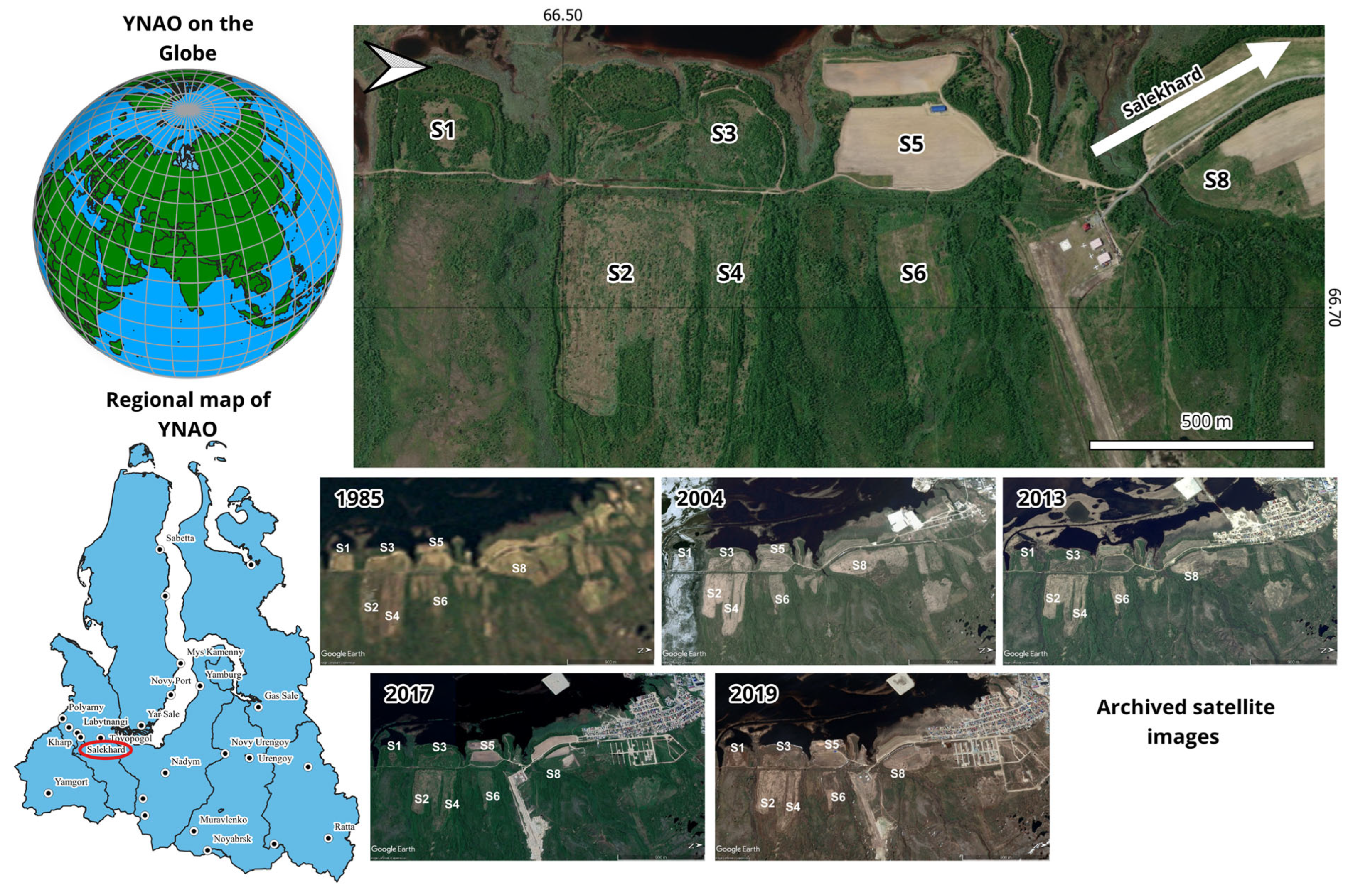
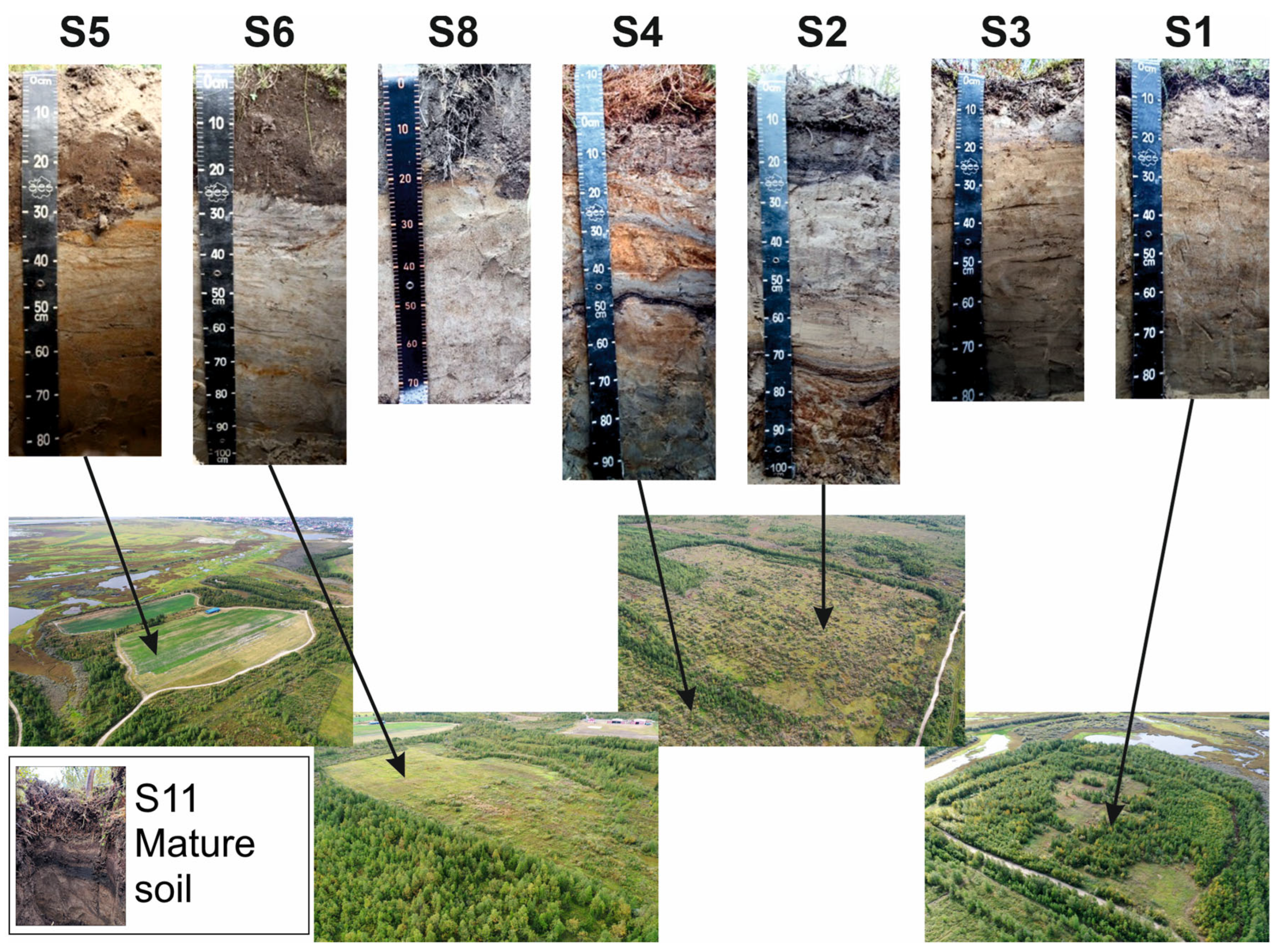

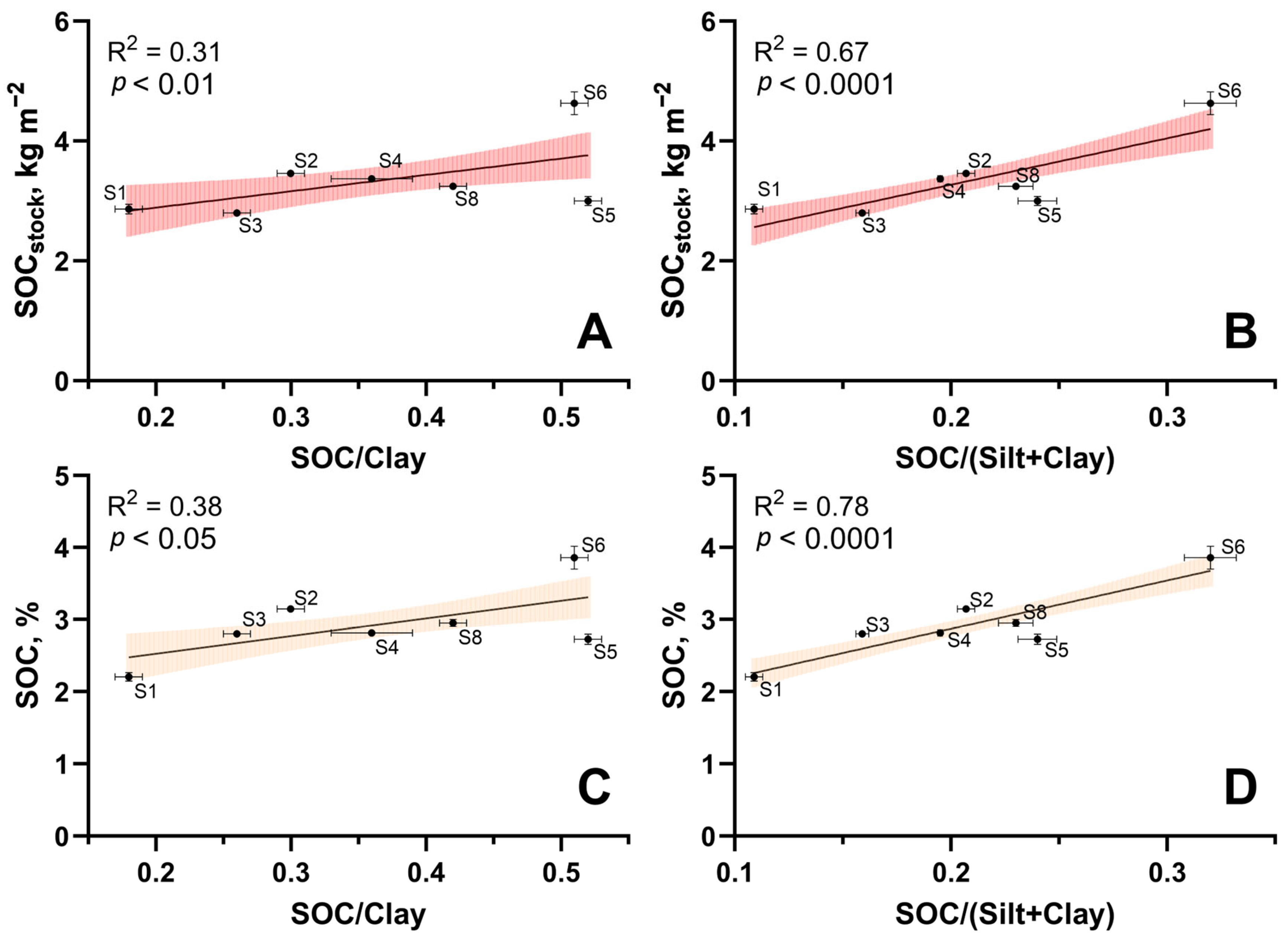
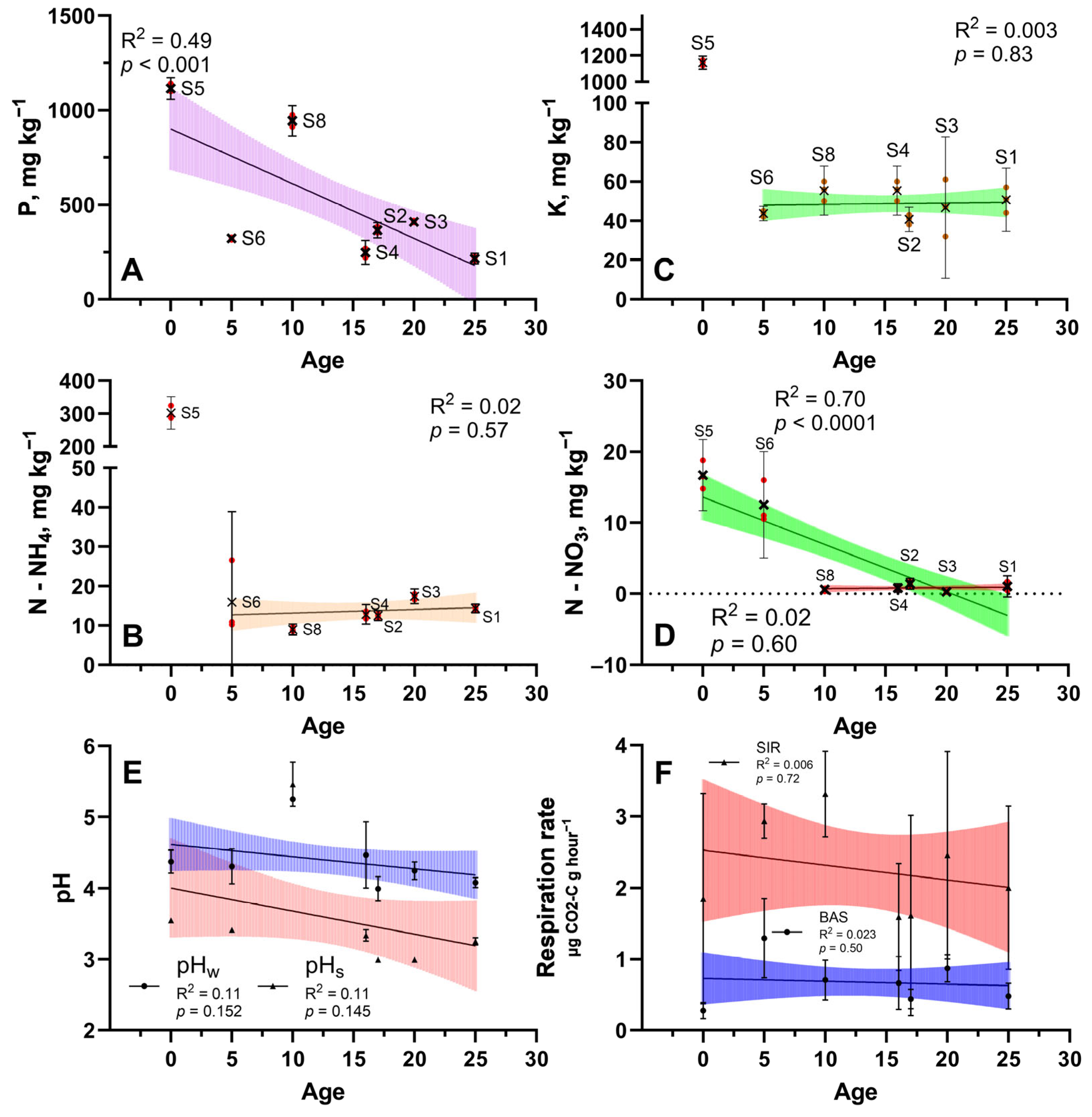
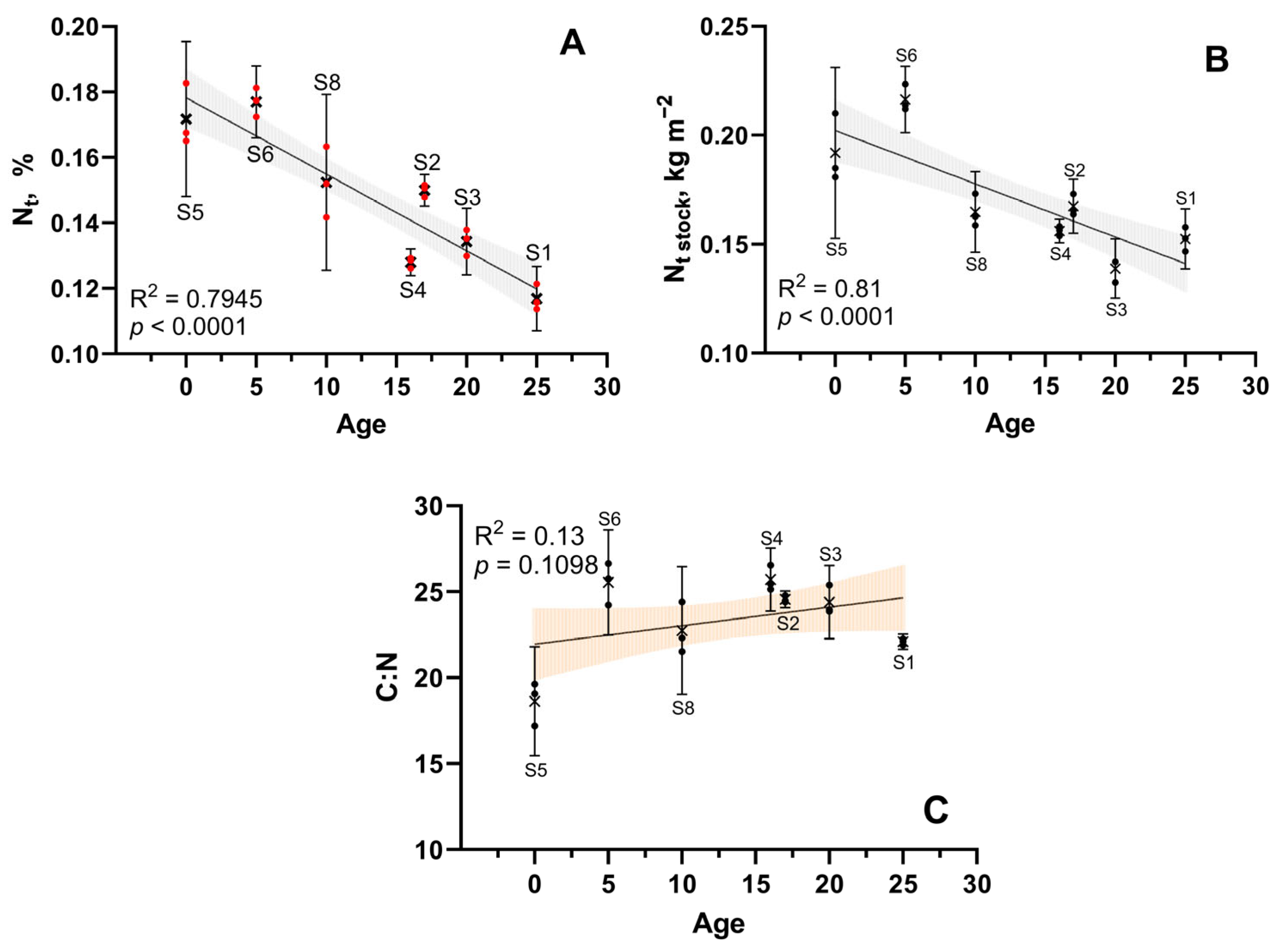
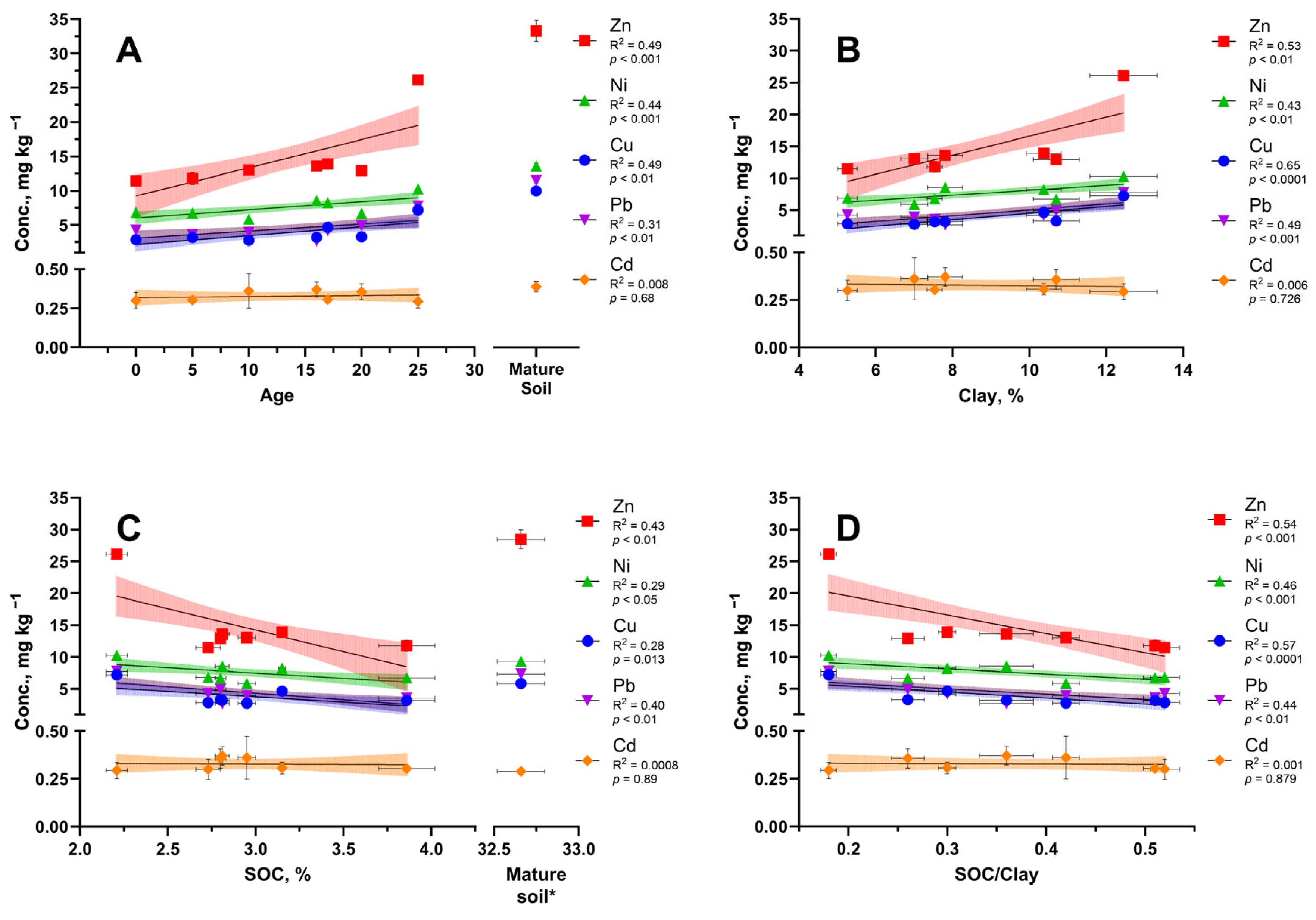
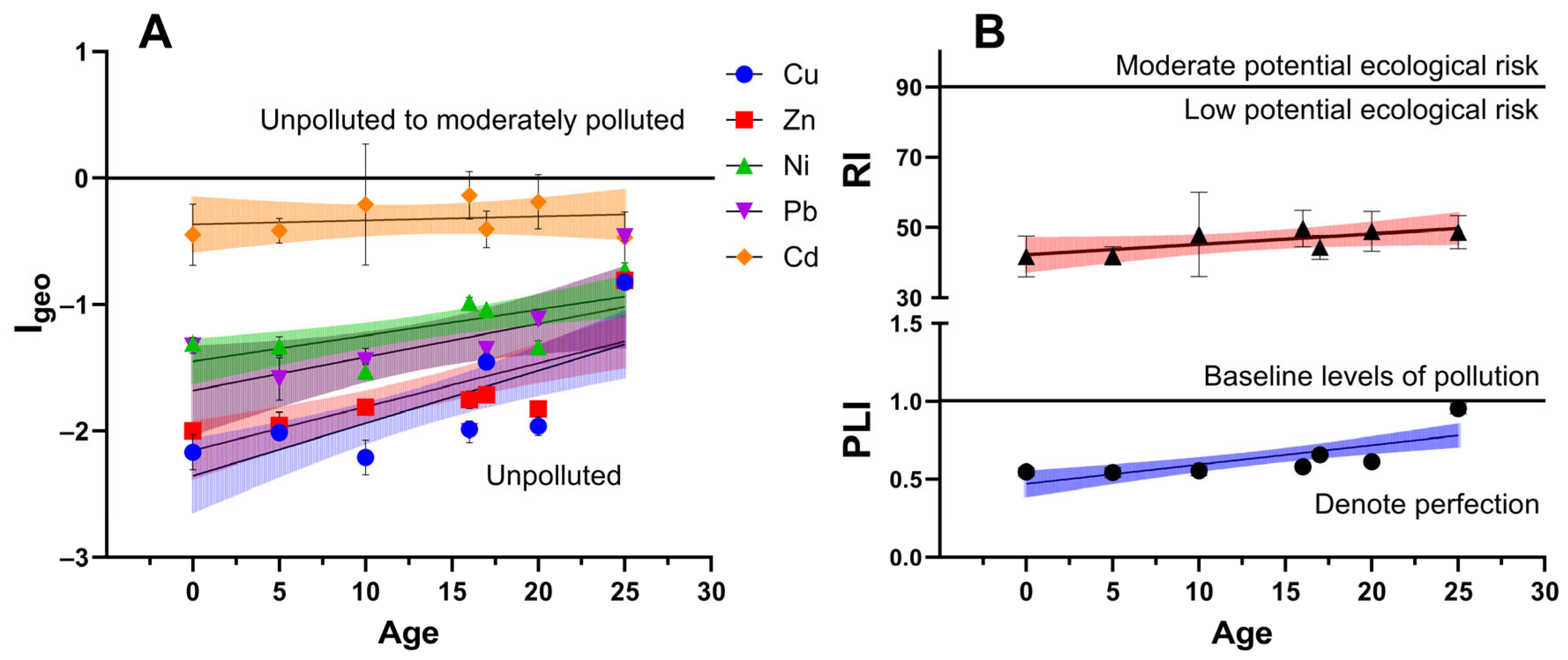
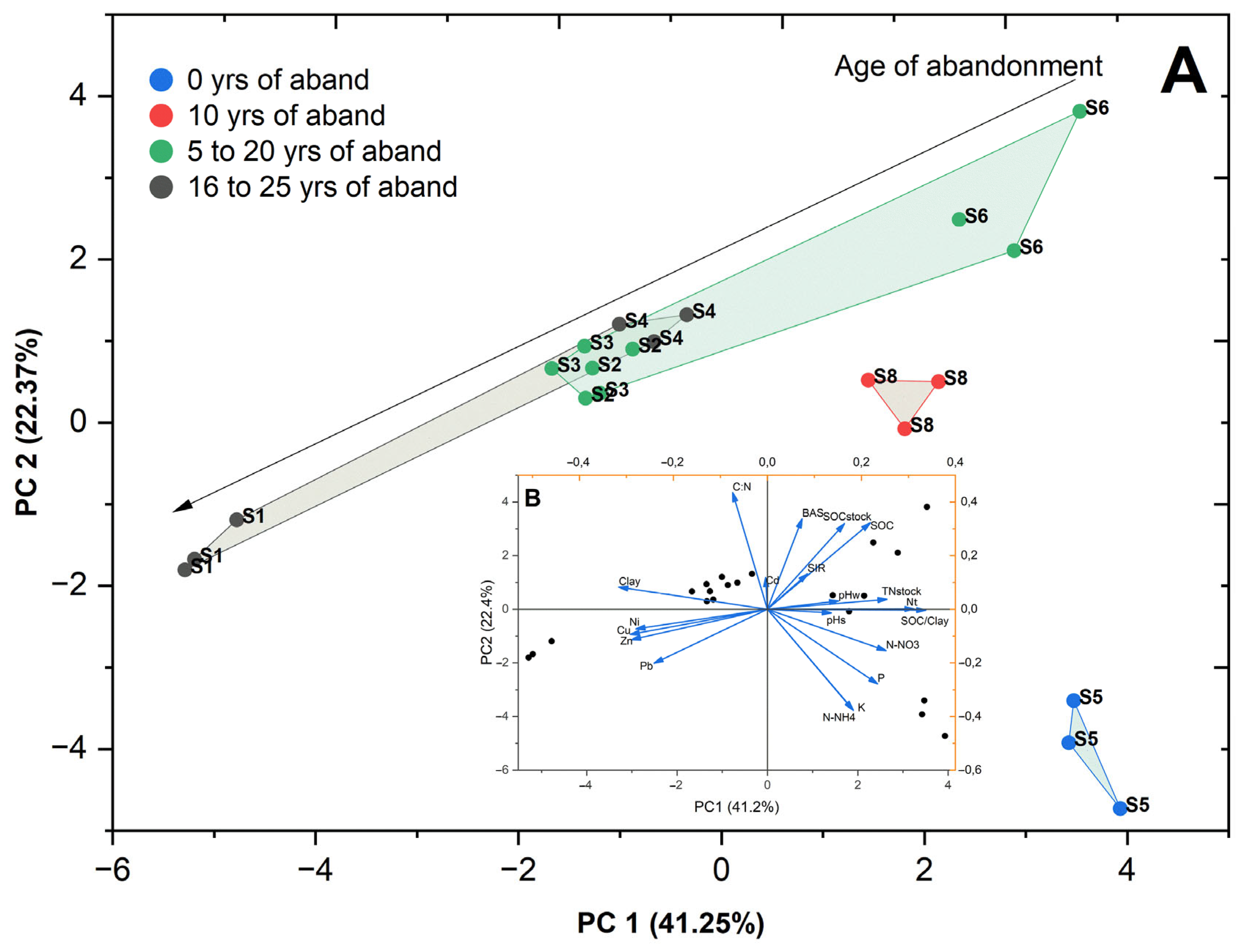
| Parameter | BD | pHw | pHs | SOC | Nt | C:N | P | K | N-NH4 | N-NO3 |
|---|---|---|---|---|---|---|---|---|---|---|
| Units | g cm−3 | - | % | - | mg kg−1 | |||||
| Value | 0.22 | 3.3 ± 0.1 | 2.3 ± 0.1 | 32.6 ± 0.1 | 1.4 ± 0.1 | 26.3 | 977 ± 29 | 80 ± 9 | 13.6 ± 0.6 | 32.3 ± 1.7 |
Disclaimer/Publisher’s Note: The statements, opinions and data contained in all publications are solely those of the individual author(s) and contributor(s) and not of MDPI and/or the editor(s). MDPI and/or the editor(s) disclaim responsibility for any injury to people or property resulting from any ideas, methods, instructions or products referred to in the content. |
© 2025 by the authors. Licensee MDPI, Basel, Switzerland. This article is an open access article distributed under the terms and conditions of the Creative Commons Attribution (CC BY) license (https://creativecommons.org/licenses/by/4.0/).
Share and Cite
Nizamutdinov, T.; Yang, S.; Abakumov, E. Post-Agricultural Shifts in Soils of Subarctic Environment on the Example of Plaggic Podzols Chronosequence. Agronomy 2025, 15, 584. https://doi.org/10.3390/agronomy15030584
Nizamutdinov T, Yang S, Abakumov E. Post-Agricultural Shifts in Soils of Subarctic Environment on the Example of Plaggic Podzols Chronosequence. Agronomy. 2025; 15(3):584. https://doi.org/10.3390/agronomy15030584
Chicago/Turabian StyleNizamutdinov, Timur, Sizhong Yang, and Evgeny Abakumov. 2025. "Post-Agricultural Shifts in Soils of Subarctic Environment on the Example of Plaggic Podzols Chronosequence" Agronomy 15, no. 3: 584. https://doi.org/10.3390/agronomy15030584
APA StyleNizamutdinov, T., Yang, S., & Abakumov, E. (2025). Post-Agricultural Shifts in Soils of Subarctic Environment on the Example of Plaggic Podzols Chronosequence. Agronomy, 15(3), 584. https://doi.org/10.3390/agronomy15030584







